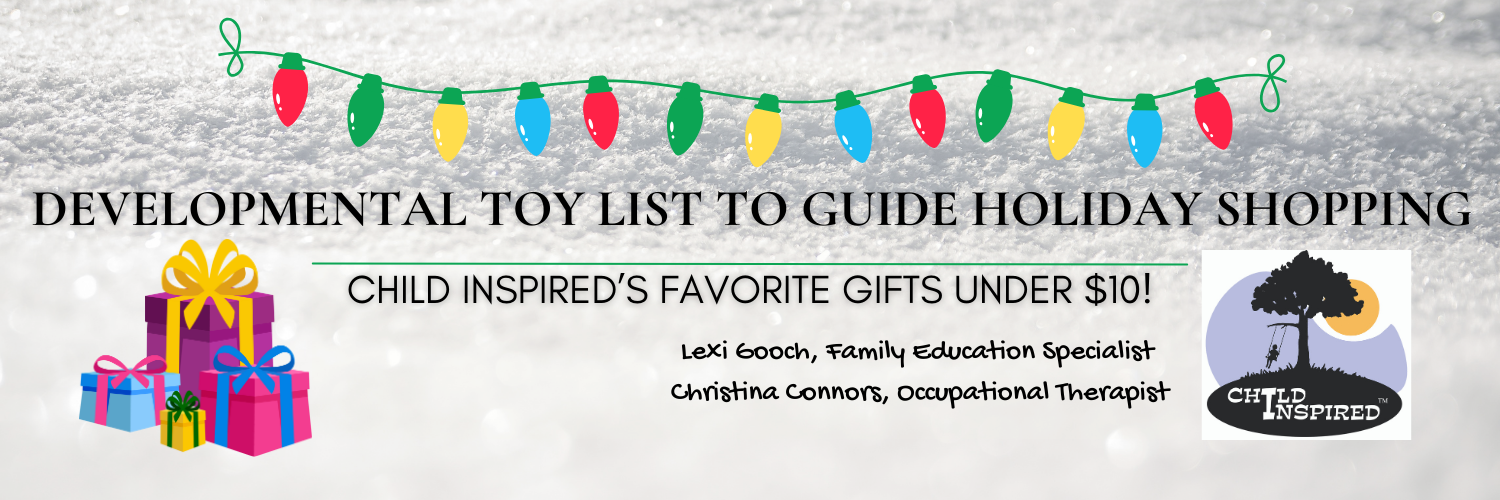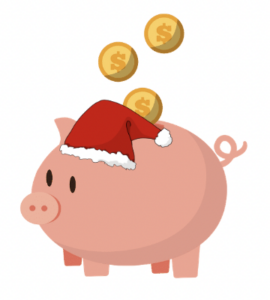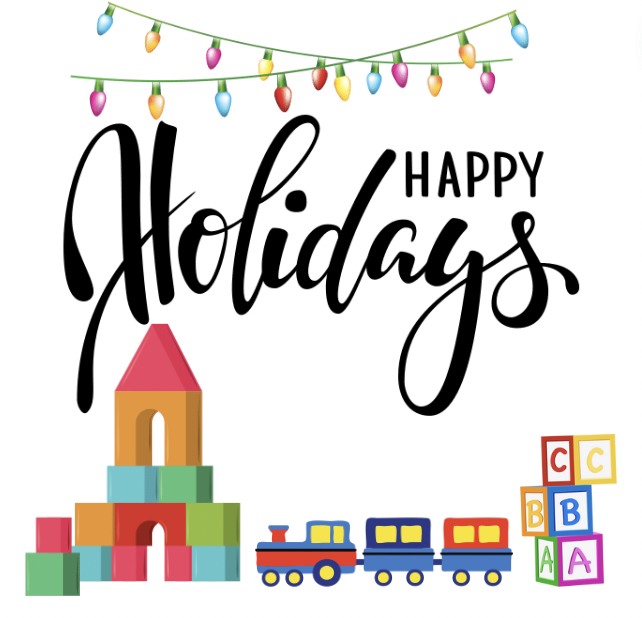Developmental Toy List to Guide Holiday Shopping

In addition to being safe, toys for young children need to match their stages of development and emerging abilities. Many toys can be created for free at home. Cardboard boxes, plastic bowls, large kitchen utensils, and other “simple treasures” can be used in more than one way and encourage creative exploration by children of different ages. However, when you need some guidance or when family members are asking for ideas to fill your child’s toybox at the holidays, choosing high-quality toys is a great opportunity to promote their healthy growth and development!
Toys for Young Infants—Birth through 6 months
Babies love faces and following them with their eyes. Typically, they prefer familiar faces and bright colors. Babies begin to reach and grasp, and are fascinated with what their hands and feet can do. They lift their heads and begin to roll their bodies towards sounds and sights that interest them. They often explore new experiences by putting objects in their mouths.
- Shatterproof mirrors
- Rattles that are easy to grasp to shake and transfer between their hands
- Large rings that can be held by both hands
- Textured board books
- Ribbon boxes
- Activity mat that encourages tummy time
Toys for Older Infants—7 to 12 months
Look out…baby is on the move! Typically infants go from rolling over and sitting, to scooting, bouncing, crawling, pulling themselves up, and standing. They understand their own names and other common words, can begin to identify basic body parts, find hidden objects, and dump and fill things in and out of containers.
- Bubbles
- Shape sorters
- Bead mazes
- Toys to introduce pretend play—baby dolls, puppets, plastic or wood vehicles with large wheels
- Toys for water play in the bathtub
- Toys for “dump and fill”—plastic bowls/cups, nesting toys, balls with a bin or soft basket
- Toys for early building play—Soft blocks and wooden cubes
- Toys for large muscles—large balls, push and pull toys, and low, soft things to crawl over
- Toys for music/sound exploration-small maracas or bongo drums
Toys for 1 year-olds
One-year-olds are on the go! They are beginning to walk and climb. They enjoy stories, say their first words, and can play alongside other children (often intrigued to observe). They like to explore, but need adults to keep them safe.
- Board books with simple illustrations or photographs of real objects
- Toys for music/sound exploration-cymbals, tambourines, recordings of songs & rhymes
- Toys to introduce creative play-chalk, aqua doodle sets
- Different soft textured balls for rolling and soft catch/throw play
- Toys for pretend play—dolls and doll bed, baby strollers, toy phone, stuffed animals, simple dress-up accessories (hats, purses), puppets, plastic and wood “realistic” vehicles
- Toys for building play—cardboard and wood blocks (can be smaller than those used by infants—2 to 4 inches)
- Toys for large and small muscles—puzzles with knobs, large pegboards, toys with parts that do things (dials, switches, knobs, lids), push toys (shopping cart, bubble mower), cloth tunnel
Toys for 2 year-olds
Toddlers are rapidly learning language and have some sense of danger. Nevertheless, they do a lot of physical “testing”: jumping from heights, climbing, hanging by their arms, rolling, and rough-and-tumble play. They are beginning to have improved control of their hands and fingers and like to do things with small objects.
- Toys for creative play—wide, non-toxic, washable crayons, dot markers, large paintbrushes and finger-paint, large paper for drawing and painting, colored construction paper, easel chalkboard and chalk
- Thick, puffy stickers and paper
- Toys for solving problems—wood puzzles (4 to 12 pieces), blocks that snap together (Duplo), objects to sort (by size, shape, color)
- Toys for pretend and building play—blocks, smaller (and sturdy) transportation toys, construction sets, child-sized furniture (kitchen sets, chairs, play food), dress-up clothes, puppets, and sand and water play toys
- Picture books with more details than books for younger children
- Toys for large and small muscles—large and small balls for throwing and kicking, ride-on push toy (not powered), small play tent/fort w/ tunnel, low climbers with soft mat for safety
Toys for 3-4 year olds
Preschoolers are beginning to have longer attention spans than toddlers. They are becoming more verbally expressive during their play and daily routines. They like to experiment with things and with their emerging physical skills. They like to play with others, but need adults to help model sharing and turn-taking.
- Toys for solving problems—floor puzzles (12 to 24 pieces), blocks that snap together, collections and other smaller objects to sort by size shape, color, smell, quantity, and other features—collections of shells, counting bears, etc
- Toys for pretending and building play—large blocks, blankets and “fort” building sets, transportation toys, construction sets, play food/cash register, play workbench with tools, dress-up clothes, dolls with accessories, puppets and simple puppet theaters, and sand and water play toys
- Toys for creative play—large and small crayons and markers, large and small paintbrushes and finger-paint, thick paper for drawing and painting, colored construction paper, preschooler-sized spring scissors (adult supervision at all times), larger size glue stick, easel/chalkboard and large and small chalk, playdough model tools (rollers, plastic scissors, small shaped cutters)
- Picture books with words and more detailed pictures and stories
- Toys for musical exploration—keyboards, xylophones, harmonicas
- Things for using their large and small muscles—large and small balls for kicking and throwing/catching, ride-on toys including tricycles and strider/balance bikes (bicycle helmet), taller climbers with safety material underneath, wagons and wheelbarrows, plastic bats and balls
Toys for 5- 6 year-olds
Early elementary-aged children are becoming more proficient with play that requires use of the smaller muscles in their hands. They like to play with friends. They can take turns, sharing one toy with two or more children with positive encouragement from adults.
- Toys for solving problems—puzzles (24+ pieces), simple lego kits
- Toys to encourage creative expression—crayons and markers, paintbrushes and washable paints/watercolors, large and small paper for drawing and painting, colored construction paper, child safety scissors (blunt tip), wipe-off board and markers, sticker books, modeling clay and play-dough, modeling tools, slime kits
- Books with sight words and engaging illustrations to promote interest in reading
- Toys for large and small muscles—large and small balls for kicking and throwing/catching, small safety cones to create goals/targets, bicycle (with training wheels) and scooters (bicycle helmet), balance boards/rocks for obstacle course with safety material underneath, and pounding and hammering toys

See below for links to Child Inspired’s favorite gifts under $10 & a shareable list (pdf) for reference!
Birth- 6 Months Under $10 Finds
Tummy Time Floor Mirror: click here
Rattle: click here
Sloth Ring Toy: click here
See, Touch, Feel Sensory Book: click here
Tummy Time Activity Mat: click here
7-12 Months Under $10 Finds
Bubble Machine: click here
Shape Sorting Toy: click here
Jungle Gym Bead Toy: click here
Bathtub Toy: click here
Nesting Cups: click here
Building Blocks: click here
Animal Themed Ball: click here
Musical Toy: click here
1-Year-Olds Under $10 Finds
The Very Hungry Caterpillar Board Book: click here
Light-up Drums: click here
Sidewalk Chalk: click here
Musical Toy Phone: click here
ABC Blocks: click here
Knob Puzzle: click here
2-Year-Olds Under $10 Finds
Construction Paper: click here
Vehicle Puffy Sticker Set: click here
Wooden Vehicle Puzzle: click here
Toy Cars: click here
The Rainbow Fish Board Book: click here
Nail and Hammer Puzzle: click here
3-4-Year-Olds Under $10 Finds
Solar System Floor Puzzle: click here
Play Food: click here
Crayons: click here
Fox In Socks Book: click here
Xylophone Toy: click here
Practice Baseball Set: click here
5-6-Year-Olds Under $10 Finds
Disney Wish Puzzle: click here
Watercolor Paint: click here
The Day the Crayons Quit Book: click here
Sports Cones: click here
And to save for reference or share with family and friends, use the link below to download a shareable pdf of developmentally-appropriate toy recommendations:
Developmental Toy List-Recommendations from Pediatric Specialists at Child Inspired

Authored by Lexi Gooch: Child Inspired’s Family Education Specialist
 Lexi joined the Child Inspired practice in April 2023. Lexi received her B.S. in Early Childhood Education with dual certification in Special Education in 2019 and her M.Ed. in Special Education in 2020 at Eastern University. Lexi currently works full-time in the Cape Henlopen School District for the Sussex Consortium at Love Creek Elementary School. Lexi has developed and implemented Individualized Education Plans to best support students’ individual needs. Lexi has also developed child-centered lesson plans in the areas of literacy, math, science, and social studies accommodating students and utilizing a variety of instructional methods. Lexi has demonstrated mastery in the nine elements of the Pyramid Approach to Education model and is a certified Teacher of Students with Autism or Students with Severe Intellectual Disabilities. Lexi is also trained in the Picture Exchange Communication System. Lexi is a positive advocate for inclusive learning environments and experiences for children and families with a variety of needs. Lexi has a passion for working with children and developing a partnership with families to support children both at school and at home. As a former field hockey player and field hockey coach, Lexi understands the value of teamwork and applies this knowledge and experience to her approach to working with children and families. Lexi’s responsibilities within Child Inspired include developing and implementing therapeutic and educational groups, workshops, and trainings; building out online family resources; and developing programs to support the needs of our broader community. Lexi brings creative energy and innovative ideas to the Child Inspired practice.
Lexi joined the Child Inspired practice in April 2023. Lexi received her B.S. in Early Childhood Education with dual certification in Special Education in 2019 and her M.Ed. in Special Education in 2020 at Eastern University. Lexi currently works full-time in the Cape Henlopen School District for the Sussex Consortium at Love Creek Elementary School. Lexi has developed and implemented Individualized Education Plans to best support students’ individual needs. Lexi has also developed child-centered lesson plans in the areas of literacy, math, science, and social studies accommodating students and utilizing a variety of instructional methods. Lexi has demonstrated mastery in the nine elements of the Pyramid Approach to Education model and is a certified Teacher of Students with Autism or Students with Severe Intellectual Disabilities. Lexi is also trained in the Picture Exchange Communication System. Lexi is a positive advocate for inclusive learning environments and experiences for children and families with a variety of needs. Lexi has a passion for working with children and developing a partnership with families to support children both at school and at home. As a former field hockey player and field hockey coach, Lexi understands the value of teamwork and applies this knowledge and experience to her approach to working with children and families. Lexi’s responsibilities within Child Inspired include developing and implementing therapeutic and educational groups, workshops, and trainings; building out online family resources; and developing programs to support the needs of our broader community. Lexi brings creative energy and innovative ideas to the Child Inspired practice.
